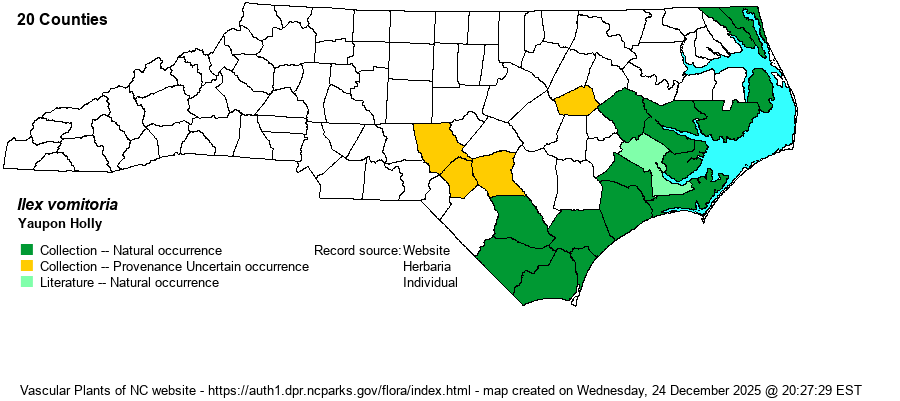| Author | Aiton | |
| Distribution | Along the entire coastline, in all counties bordering the Atlantic. Also occurs sporadically farther inland in the Coastal Plain, but because the species is used as an ornamental, many such records away from coastal counties are of uncertain provenance. Records from the Sandhills of Cumberland, Hoke, and Moore counties are escapes from cultivation and are locally established.
This is a Southern species ranging mostly in the Coastal Plain, and south of NC is not restricted to coastal areas. It occurs from southeastern VA to southern FL and much of eastern TX.
| |
| Abundance | Common and easily found within a mile of the coast, but more localized farther inland. | |
| Habitat | This is one of the few woody species – along with Live Oak (Quercus virginiana), Southern Red Cedar (Juniperus silicicola), and several Morella species – that grow on coastal sand flats and low dunes, behind the high dune line. It is also a characteristic species of maritime forests and maritime shrub thickets. Farther inland it can grow on deep sands of Carolina bay rims or sand barrens. |
| Phenology | Blooms from March to May, and fruits from September to November, persisting into the winter. | |
| Identification | This familiar coastal evergreen shrub, or rarely a small tree, has a widely spreading form, often rounded, and grows to about 10 feet tall, rarely to 20 feet. The alternate leaves are very thick, shiny, and dark green, and are small for a holly; they are elliptical in shape with scalloped margins, reaching only about 1-inch long on average. In fall and winter, the shrubs contain an abundance of red “berries”, making the species very recognizable. Next to the American Holly (I. opaca), this is probably the easiest of the state’s holly species for the layman to identify. The dense evergreen cover and red fruit are very important to birds in winter, and many a Yaupon Holly bush is guarded at that season by a Northern Mockingbird, chasing away other birds from stealing “its” berries. However, Yaupon Holly is vegetatively extremely similar to the alien I. crenata in leaf shape, size, and crenate margins, but the leaf tip is notched or retuse and has a small mucro in the notch (vs. obtuse or acute and has a sharp tooth). The fruits are red (vs. black in I. crenata). | |
| Taxonomic Comments | None
| |
| Other Common Name(s) | Yaupon. Although a dictionary pronunciation of Yaupon is -- perhaps correctly – YAW-pun, perhaps as the town in coastal NC is pronounced “YO-pahn Beach” – most biologists call the species like the town name – YO-pahn. Perhaps more references give just Yaupon as the common name instead of Yaupon Holly. For consistency with most others in this genus, the word "Holly" is best used, in order to avoid an idiosyncratic name. | |
| State Rank | S4 | |
| Global Rank | G5 | |
| State Status | | |
| US Status | | |
| USACE-agcp | FAC link |
| USACE-emp | FAC link |

